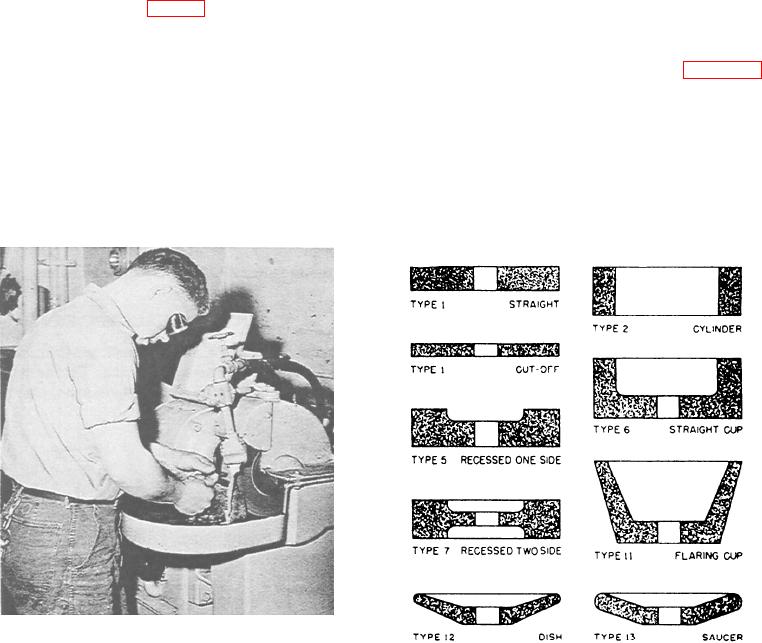
and shaper cutting tools; twist drills; and handtools
single-point tools embedded in a toolholder or
such as chisels and center punches. These grinders do
bonding agent. Each of these grains removes a very
not have installed coolant systems; however, a
small chip from the workpiece as it makes contact on
container of water is usually mounted on the front of
each revolution of the grinding wheel.
the grinder.
An ideal cutting tool is one that will sharpen itself
when it becomes dull. This, in effect, happens to the
Bench grinders usually have grinding wheels up
abrasive grains. As the individual grains become dull,
to 8 inches in diameter and 1 inch thick. A wheel
the pressure on them causes them to fracture and
guard encircles the grinding wheel except for the
present new sharp cutting edges to the work. When
work area. An adjustable toolrest steadies the
the grains can fracture no more, the pressure becomes
workpiece. You can move it in or out or swivel it to
too great and they are released from the bond,
adjust to grinding wheels of different diameters. An
allowing a new layer of sharp grains to contact the
adjustable eyeshield made of safety glass should be
work.
mounted on the upper part of the wheel guard.
Position this shield to deflect the grinding wheel
SIZES AND SHAPES
particles away from you.
Pedestal grinders (fig. 5-2) are usually heavy-
The size of a grinding wheel is determined by its
duty bench grinders mounted on a pedestal fastened to
diameter in inches, the diameter of its spindle hole,
the deck. They usually have the features of a bench
and the width of its face. Grinding wheels have too
grinder plus a coolant system, which includes a pump,
many shapes to list in this manual, but figure 5-3
storage sump, hose, and fittings to regulate and carry
shows those used most often. The type numbers are
the coolant to the wheel surface.
standard and all manufacturers use them. The shapes
are shown in cross-sectional views. The job will
dictate the shape you should use.
GRINDING WHEELS
WHEEL MARKINGS AND COMPOSITION
A grinding wheel is made of two basic elements:
(1) the abrasive grains, and (2) the bonding agent.
Grinding wheel markings are composed of six
You can think of the abrasive grains as many
stations, each of which identifies a characteristic of
28.61
Figure 5-2.--Grinding on a pedestal grinder.
Figure 5-3.--Grinding wheel shapes.
5-2

